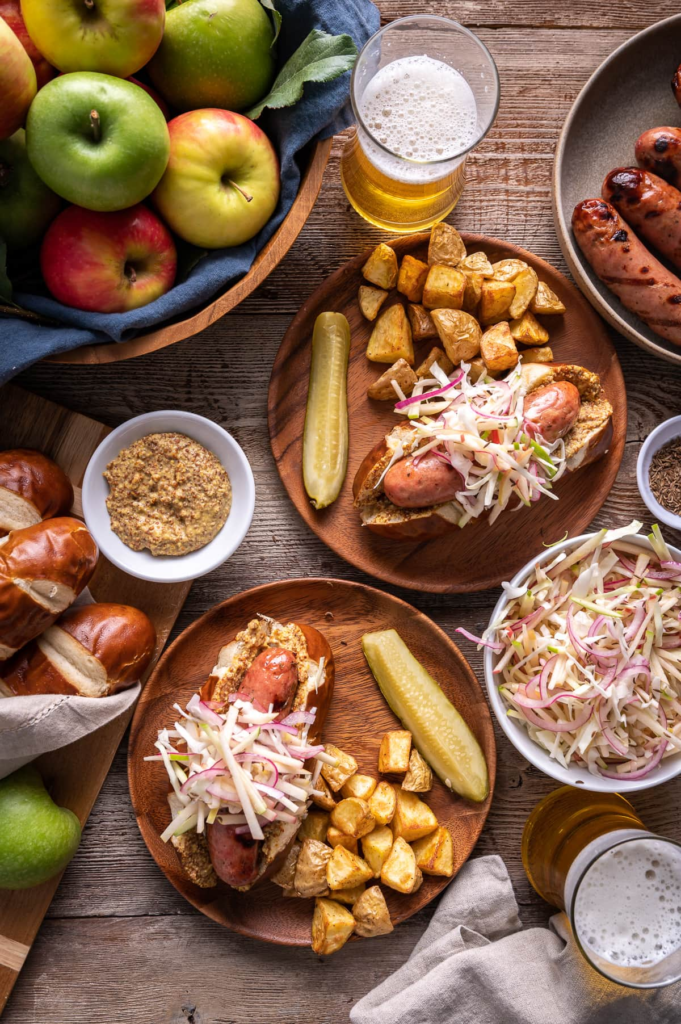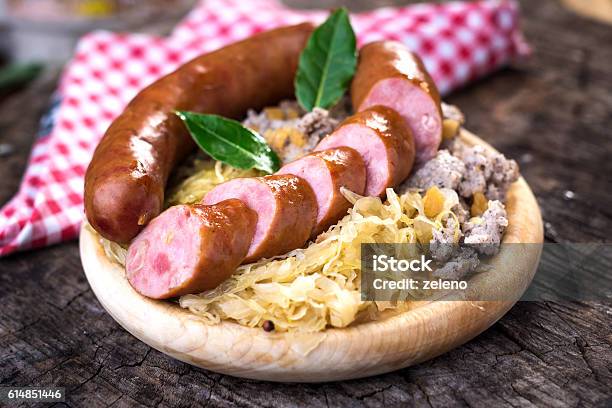Sophie Müller provides insights into the rich culinary heritage of German sausage and sauerkraut, tracing their origins, nutritional benefits, and storage guidelines. She delves into the differences between smoked sausage and kielbasa, explores the debate of store-bought versus homemade sauerkraut, and offers tantalizing recipes for enjoying these German delicacies. Additionally, she examines the health benefits of sauerkraut, advises on whether to rinse sauerkraut before use, and suggests pairing German sausage with Honey beer for an enhanced gastronomic experience.
The Backstory of German Sausage and Sauerkraut
German sausage and sauerkraut form a classic and beloved duo. They has stood the test of time. These culinary staples trace their origins back to Germany. They’ve been a fundamental part of the country’s food culture for centuries.
Sausage-making has been a traditional practice in Germany since the Middle Ages. Each region developed its unique styles and flavors. Famous sausages like Bratwurst, Weisswurst, and Knockwurst are known for their distinctive taste and texture.
On the other hand, sauerkraut, fermented cabbage, has been a German favorite for over 2,000 years. This tangy and crunchy condiment isn’t just delicious, but also packed with probiotics and nutrients beneficial for digestion and overall health.
Combining these elements results in a hearty and flavorful dish. They has become a German cuisine staple. Whether enjoyed together in a sausage and sauerkraut dish, or separately in various recipes, these ingredients continue to be cherished by people worldwide.
The backstory of German sausage and sauerkraut reflects Germany’s rich culinary heritage, and the enduring popularity of these delicious foods.
Store-bought VS homemade German Sauerkraut
German sauerkraut sparks a heated discussion among food enthusiasts – store-bought versus homemade.
Opting for store-bought sauerkraut is a convenient way to infuse German flavors into dishes without the hassle. Yet, store-bought versions might contain preservatives. They lack the authenticity and freshness found in homemade varieties.
Conversely, homemade German sauerkraut entails fermenting cabbage with salt and spices over time. They have a probiotic-rich and flavorful condiment. Furthermore, making it from scratch allows for customization with ingredients and fermentation duration to cater to personal preferences.
I prefer my own pickled sauerkraut to this. Because it has more of a fresh crispness.
German Sausage and Sauerkraut Nutrition Facts
German sausage is a great source of protein, iron, and zinc. It is essential to consume it in moderation due to its high fat and sodium content.
In contrast, sauerkraut is low in calories and packed with fiber, vitamins C and K, and gut-friendly probiotics. Its tangy flavor perfectly complements the richness of the sausage.
When paired together, German sausage and sauerkraut form a well-balanced meal. They satisfies both your cravings and dietary needs. Remember to choose high-quality sausage and enjoy it in moderation to fully appreciate this delightful duo.
How to Make German Sausage and Sauerkraut
Do you want to taste the essence of Germany in your own home? One of Germany’s most beloved and iconic dishes is the combination of hearty sausage and tangy sauerkraut. Now, we’ll walk you through creating this traditional feast step by step.
Start by gathering your ingredients: high-quality German sausage, sauerkraut, onions, apples, caraway seeds, and mustard. Cook the sausages in a pan until they’re browned and cooked through. In another pan, sauté the onions and apples until they’re soft and caramelized. Then, add the sauerkraut and caraway seeds to the pan and cook until the flavors blend.
Once everything is cooked perfectly, serve the hot sausage and sauerkraut with a side of mustard for dipping. The mix of savory sausage, tangy sauerkraut, and sweet apples will transport you to the heart of Germany with every bite.
Whether you’re throwing an Oktoberfest party or just exploring new culinary traditions. Making German sausage and sauerkraut at home is a delicious and fulfilling experience. Embrace the flavors of Germany and savor this comforting, flavorful dish with loved ones.
Authentic German Sausage: A Delicious Match with Honey Beer
The rich flavors and unique seasonings of German sausage attract food enthusiasts worldwide. To enhance this experience, pair it with a refreshing Honey beer!
Combining German sausage with Honey beer enhances the dining experience. The sweetness of the Honey beer complements the german sauerkraut and sausage flavors of the sausage. Creat a delightful fusion of tastes. Additionally, the beer’s carbonation helps cleanse the palate between each flavorful bite.
So, the next time you indulge in authentic German sausage, don’t forget to grab a cold glass of Honey beer to enrich your gastronomic journey.
Smoked Sausage with Potatoes, Sauerkraut & Ale
Looking for a warm, hearty dish on a cold day? Try smoked sausage with potatoes, sauerkraut, and ale. This classic dish combines flavors to create a satisfying meal. And they will become a family favorite.
To make this dish, first, brown the smoked sausage in a skillet until caramelized. Then, add diced potatoes and sauerkraut, letting them cook until tender and infused with sausage flavors. The dish truly shines when you pour in ale, enhancing its flavor.
This meal is delicious and easy to prepare. Ideal for busy weeknights or lazy weekends. The mix of protein-rich sausage, hearty potatoes, and tangy sauerkraut creates a balanced and satisfying meal.
For a comforting and delicious dinner, try making smoked sausage with potatoes, sauerkraut, and ale.
Tasty German Sausages with Bacon and Apple Sauerkraut Recipe
In the world of hearty and flavorful traditional German cuisine, one dish stands out – german sauerkraut and sausage with bacon and apple sauerkraut. This blend of flavors mixes the smoky bacon, tangy sauerkraut, and savory German sausages. They creat a culinary delight that pleases the palate and comforts the soul.

To make this delicious dish, begin by frying bacon in a skillet until it’s crispy and aromatic. Then, cook thinly sliced apples in the bacon fat until they caramelize and turn golden. Mix in sauerkraut, a splash of apple cider vinegar, and a sprinkle of brown sugar to balance the tartness.
Afterward, grill or pan-fry your preferred German sausages until they’re perfectly cooked – moist inside with a crispy, lightly charred outside. Present the sausages on a layer of bacon and apple sauerkraut, topped with fresh parsley for color and a burst of freshness.
This meal is a treat for the senses,and a tribute to Germany’s culinary legacy. Whether relished at an Oktoberfest event or as a comforting home-cooked meal, German sausages with bacon and apple sauerkraut will satisfy cravings and leave diners yearning for more.
Air Fryer German Sausage
If you’re a fan of German sausage and want a healthier way to enjoy it, your solution is the trusty air fryer! Cooking your German sausage in an air fryer allows you to indulge in this tasty treat guilt-free, without the excess oil and calories.
Air fryers cook food using hot air circulation, giving you that beloved crispy exterior without deep frying. This cooking method not only reduces the need for oil but also lowers the overall fat content of your dish.
To cook your German sausage in an air fryer, start by preheating it, placing the sausages in the basket, and bake at 350°F for 15 minutes. The result? Perfectly cooked sausages with a juicy interior and a crispy exterior.
With the convenience and health perks of using an air fryer, you can savor your favorite German sausage more often without sacrificing taste or health. Give this method a try today to take your sausage enjoyment to the next level!
How to Store German Sausage and Sauerkraut
Preserving the rich flavors of German cuisine requires proper storage of German sausage and sauerkraut. To keep your favorite German delicacies fresh and flavorful for longer periods, follow these tips:
Refrigeration is key. Refrigerate German sausage and sauerkraut promptly after purchase. Keep sausages in their original packaging or transfer them to an airtight container. Store sauerkraut in a glass or plastic container with a tight-fitting lid.
Maintain a consistent temperature in the refrigerator. Keep German sausage and sauerkraut stored at temperatures below 40°F (4°C) to prevent bacterial growth and maintain freshness.
Separate German sausage and sauerkraut when storing them. This prevents flavors from blending, maintains the authenticity of each dish, and prevents cross-contamination.
Label containers with the date of purchase to keep track of freshness. German sausage can typically last in the refrigerator for up to two weeks, while sauerkraut can last for several months when stored properly.
By following these storage tips, you can enjoy the delightful flavors of German sausage and sauerkraut for an extended period. For more culinary tips and tricks, stay tuned to our blog for updates!
Should you rinse German sauerkraut before using it?
Cooks are divided on the topic of rinsing sauerkraut before use. We will delve into this subject and equip you with the necessary information to make a well-informed decision.
Rinsing sauerkraut is not a necessary step, but a personal choice. I prefer not to rinse it. Some opt to rinse it to lessen its sourness and saltiness, while others relish the potent flavor as is. Rinsing can also help eliminate excess brine. It might be overly salty for some tastes.
If you choose to rinse your sauerkraut, ensure to do so gently under cold running water. Avoid hot water as it can diminish the beneficial probiotics in the fermented cabbage. Taste a small portion of the rinsed sauerkraut to gauge the flavor and adapt the rinsing process to suit your preferences.
Is German Sauerkraut Good for me?
German sauerkraut, a traditional fermented cabbage dish, has a long history in German cuisine. But does it benefit your health? Let’s delve into the potential advantages of adding German sauerkraut to your diet.
- Probiotic Powerhouse: Rich in beneficial probiotics like Lactobacillus bacteria, German sauerkraut is crucial for gut health. These probiotics aid in balancing gut flora to enhance digestion and boost immune function.
- Nutrient-Rich: Sauerkraut is loaded with vitamins C, K, and B6, along with minerals such as iron, manganese, and potassium. These nutrients possess antioxidant properties, bolster bone health, and help regulate blood pressure.
- Digestive Aid: The fermentation process that sauerkraut undergoes enhances its bioavailability and facilitates digestion. This can particularly benefit individuals with digestive concerns or anyone seeking to boost their gut health.
- Low in Calories: German sauerkraut is a low-calorie food that can enhance various dishes as a flavorful and nutritious condiment.
In summary, German sauerkraut provides a variety of health benefits through its probiotic content, nutrient richness, and digestive support. Incorporating this tangy and crunchy delight into your diet may enhance your overall well-being. Remember, as with all foods, moderation is crucial. Enjoy German sauerkraut as part of a balanced diet to reap its optimal health advantages.
Smoked Sausage vs. Kielbasa: What Sets Them Apart
When it comes to sausages, confusion often arises between smoked sausage and kielbasa. Both are tasty choices for various dishes, yet they differ in some key aspects.
Smoked sausage is a broad category, they cover a variety of sausages smoked to boost flavor and preserve the meat. It can be crafted from pork, beef, or poultry, and seasoned with diverse herbs and spices. Smoked sausages come in different sizes and may be fresh or fully cooked.
Conversely, kielbasa specifically denotes a type of smoked sausage originating from Poland. Made predominantly from pork, it boasts a unique taste profile from seasonings like garlic, pepper, and other spices. Kielbasa is commonly enjoyed grilled, boiled, or pan-fried and is a mainstay in Polish cuisine.
Q&A
- What are the differences between smoked sausage and kielbasa?
Smoked sausage is a broad category of sausages made with smoked meat, whereas kielbasa specifically refers to a type of smoked sausage originating from Poland. Kielbasa is primarily made from pork and seasoned with garlic, pepper, and spices, distinguishing it from other smoked sausages. - Should German sauerkraut be rinsed before use?
Rinsing German sauerkraut is a personal choice. some prefer to lessen its sourness and saltiness by rinsing it under cold water. However, rinsing may diminish the beneficial probiotics in fermented cabbage, so it’s essential to consider individual taste preferences before deciding. - Are German sausage and sauerkraut a healthy dietary choice?
German sausage provides protein, iron, and zinc. but they should be consumed in moderation due to its high fat and sodium content. Sauerkraut, on the other hand, is low in calories, high in fiber and vitamins, and contains gut-friendly probiotics, offering several nutritional benefits when included in a balanced diet. - How can you store German sausage and sauerkraut?
Refrigerate German sausage and sauerkraut promptly after purchase, store them at temperatures below 40°F (4°C), keep them in separate containers, and label them with the purchase date to monitor freshness. German sausage can last up to two weeks. Sauerkraut can be stored for several months when stored properly.
By following these guidelines, and exploring the diverse aspects of German sausage and sauerkraut, you can deepen your understanding of these classic culinary delights, and savor them to the fullest.
More Information
- References from GREG’S CUMBERLACHIA KITCHEN
- Full Report in Sauerkraut on Wiki.
- Click to learn about Get Ready for the Ultimate October Festival Germany [2024]
- Click to learn about German 1.4116 Stainless Steel, The Perfect Material For Making Kitchen Knives
- [Video] Home Made German Sausage & Sauerkraut



